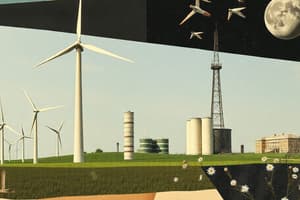Podcast
Questions and Answers
What is a key strategy to reduce greenhouse gas emissions and slow climate change?
What is a key strategy to reduce greenhouse gas emissions and slow climate change?
- Promoting sustainable consumption and production patterns
- Transitioning to renewable energy sources (correct)
- Investing in fossil fuel combustion
- Implementing carbon capture and storage technologies
What is the projected sea-level rise by 2100, depending on emission scenarios?
What is the projected sea-level rise by 2100, depending on emission scenarios?
- 26 cm to 82 cm (correct)
- 10 cm to 20 cm
- 50 cm to 100 cm
- 1 m to 2 m
What is a consequence of changes in weather patterns?
What is a consequence of changes in weather patterns?
- Increased frequency and severity of heatwaves (correct)
- Decreased mortality rates
- Increased crop yields
- Improved mental health concerns
What is the main contributor to the warming potential of greenhouse gases?
What is the main contributor to the warming potential of greenhouse gases?
What is the definition of global warming?
What is the definition of global warming?
What is a cause of global warming?
What is a cause of global warming?
Flashcards are hidden until you start studying
Study Notes
Climate Change
Climate Mitigation
- Strategies to reduce greenhouse gas emissions and slow climate change:
- Transition to renewable energy sources (e.g. solar, wind)
- Increase energy efficiency in buildings and industry
- Electrify transportation and promote sustainable land use
- Carbon capture and storage technologies
- Implement carbon pricing and policies
Sea-level Rise
- Causes:
- Melting of glaciers and polar ice caps
- Thermal expansion of seawater
- Consequences:
- Coastal erosion and flooding
- Saltwater intrusion into freshwater sources
- Loss of land and habitat for coastal ecosystems
- Projection: 26 cm to 82 cm rise by 2100, depending on emission scenarios
Weather Patterns
- Changes in:
- Temperature: increased frequency and severity of heatwaves
- Precipitation: more frequent and intense droughts and floods
- Extreme weather events: increased frequency and severity of storms, wildfires, and landslides
- Impacts on:
- Agriculture: altered growing seasons, crop yields, and food security
- Human health: increased mortality, morbidity, and mental health concerns
Greenhouse Gases
- Main contributors:
- Carbon dioxide (CO2): 65% of warming potential
- Methane (CH4): 20% of warming potential
- Nitrous oxide (N2O): 5% of warming potential
- Fluorinated gases (F-gases): 2% of warming potential
- Sources:
- Fossil fuel combustion
- Deforestation and land-use changes
- Agriculture and livestock
Global Warming
- Definition: long-term trend of rising average global temperatures
- Causes:
- Increase in greenhouse gas concentrations
- Aerosol emissions and volcanic eruptions
- Consequences:
- Melting of glaciers and sea-level rise
- Changes in weather patterns and extreme weather events
- Impacts on ecosystems, biodiversity, and human societies
Sustainability
- Definition: meeting present needs without compromising future generations' ability to meet their own needs
- Strategies:
- Transition to a circular economy
- Implement sustainable agriculture and forestry practices
- Promote sustainable consumption and production patterns
- Invest in renewable energy and energy efficiency
- Implement climate-resilient infrastructure and urban planning
Climate Change Mitigation
- Transition to renewable energy sources (e.g., solar, wind) to reduce greenhouse gas emissions
- Increase energy efficiency in buildings and industry to decrease energy consumption
- Electrify transportation and promote sustainable land use to minimize emissions
- Implement carbon capture and storage technologies to reduce emissions
- Establish carbon pricing and policies to promote sustainable practices
Sea-level Rise
- Causes: melting of glaciers and polar ice caps, and thermal expansion of seawater
- Consequences: coastal erosion and flooding, saltwater intrusion into freshwater sources, and loss of land and habitat for coastal ecosystems
- Projection: 26 cm to 82 cm rise by 2100, depending on emission scenarios
Weather Patterns
- Increased frequency and severity of heatwaves due to rising temperatures
- More frequent and intense droughts and floods due to changes in precipitation patterns
- Increased frequency and severity of storms, wildfires, and landslides due to extreme weather events
- Impacts on agriculture: altered growing seasons, crop yields, and food security
- Impacts on human health: increased mortality, morbidity, and mental health concerns
Greenhouse Gases
- Main contributors: carbon dioxide (CO2, 65% of warming potential), methane (CH4, 20% of warming potential), nitrous oxide (N2O, 5% of warming potential), and fluorinated gases (F-gases, 2% of warming potential)
- Sources: fossil fuel combustion, deforestation and land-use changes, agriculture and livestock
Global Warming
- Definition: long-term trend of rising average global temperatures
- Causes: increase in greenhouse gas concentrations, aerosol emissions, and volcanic eruptions
- Consequences: melting of glaciers and sea-level rise, changes in weather patterns and extreme weather events, impacts on ecosystems, biodiversity, and human societies
Sustainability
- Definition: meeting present needs without compromising future generations' ability to meet their own needs
- Strategies: transition to a circular economy, implement sustainable agriculture and forestry practices, promote sustainable consumption and production patterns, invest in renewable energy and energy efficiency, and implement climate-resilient infrastructure and urban planning
Studying That Suits You
Use AI to generate personalized quizzes and flashcards to suit your learning preferences.




